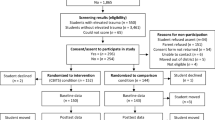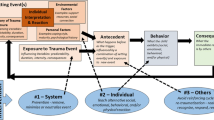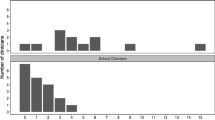Abstract
On the basis of clinical experience with traumatized adolescents, the authors developed a psychoeducational group intervention that educates participants about trauma with the goal of minimizing their propensity toward reenactment and risk-taking behavior that exposes them to additional trauma. A pilot study with a community population showed promising results: traumatized high-school students' learning about trauma in a psychoeducational group related to healthier attitudes toward risk-taking behaviors. Encouraged by these preliminary findings, the authors developed a more refined 12-session protocol. Each session includes a combination of trauma-related topics and exercises intended to build skills in the areas of self-regulation, empathy, and interpersonal problem-solving. This paper presents a session-by-session description illustrated with clinical examples and concludes with a plan for further program evaluation and our clinical impressions of its effectiveness.
Similar content being viewed by others
REFERENCES
Allen, J. G. (2001). Traumatic relationships and serious mental disorders. Chichester, UK: Wiley.
Allen, J. G., Kelly, K. A., & Glodich, A. (1997). A psychoeducational program for patients with trauma-related disorders. Bulletin of the Menninger Clinic, 61, 222–239.
Allen-Meares, P., Washington, R., & Welsch, B. (1990). Social work services in schools. Boston: Allyn and Bacon.
Bowen, M. (1980). Key to the use of the genogram (family diagram). In E. A. Carter & M. McGoldrick (Eds.), The family life cycle: A framework for family therapy (pp. xxiii). New York: Gardner Press.
Busen, N. (1991). Development of an adolescent risk-taking instrument. Journal of Child and Adolescent Psychiatric and Mental Health Nursing, 4, 143–149.
Davies, J. M., & Frawley, M. G. (1994). Treating the adult survivor of childhood sexual abuse. New York: BasicBooks.
Fonagy, P., & Target, M. (1997). Attachment and reflective function: Their role in self-organization. Development and Psychopathology, 9, 679–700.
Gabbard, G. O., & Wilkinson, S. M. (1994). Management of countertransference with borderline patients. Washington, DC: American Psychiatric Press.
Garbarino, J. (1995). Raising children in a socially toxic environment. San Francisco: Jossey-Bass.
Garbarino, J., Kostelny, K., & Grady, J. (1993). Children in dangerous environments: Child maltreatment in the context of community violence. In D. Cicchetti & S. L. Toth (Eds.), Child abuse, child development, and social policy. Advances in applied developmental psychology (Vol. 8, pp. 167–189). Norwood, NJ: Ablex Publishing Corporation.
Glodich, A. (1999). Psychoeducational groups for adolescents exposed to violence and abuse: Assessing the effectiveness of increasing knowledge of trauma to avert reenactment and risktaking behaviors. Unpublished doctoral dissertation, Smith College, Northampton, MA.
Glodich, A. (2001). Educating adolescents. In J. G. Allen (Ed.), Traumatic relationships and serious mental disorders. Chichester, UK: Wiley.
Greenberg, M. A., Wortman, C. B., & Stone, A. A. (1996). Emotional expression and physical health: Revising traumatic memories of fostering self-regulation? Journal of Personality and Social Psychology, 71, 588–602.
Harber, K. D., & Pennebaker, J. W. (1992). Overcoming traumatic memories. In S. Christianson (Ed.), The handbook of emotion and memory: Research and theory (pp. 359–387). Hillsdale, NJ: Erlbaum.
Harter, S. (1999). The construction of the self: A developmental perspective. New York: Guilford.
Herman, J. L. (1992). Trauma and recovery. New York: BasicBooks.
Herz, E., Goldberg, W., & Reis, J. (1984). Family life education for young adolescents: A quasiexperiment. Journal of Youth and Adolescence, 16, 309–327.
James, B. (1989). Treating traumatized children. New York: Lexington Books.
Janoff-Bulman, R. (1992). Shattered assumptions: Towards a new psychology of trauma. New York: The Free Press.
Kivel, P., & Creighton, A. (1997). Making the peace: A 15-session prevention curriculum for young people. Alameda, CA: Hunter House.
Kymissis, P. (1993). Group psychotherapy with adolescents. In H. Kaplan & B. Sadock (Eds.), Comprehensive group psychotherapy (3rd ed., pp. 577–584). Baltimore: Williams & Wilkins.
Murphy, L., Pynoos, R., & James, C. B. (1997). The trauma/grief focused group psychotherapy module of an elementary school-based violence prevention/intervention program. In J. Osofsky (Ed.), Children in a violent society (pp. 223–255). New York: Guilford.
Osofsky, J. (1997a). Children and youth violence: An overview of the issues. In J. Osofsky (Ed.), Children in a violent society (pp. 3–8). New York: Guilford.
Osofsky, J. (1997b). The violence intervention project for children and families. In J. Osofsky (Ed.), Children in a violent society (pp. 256–260). New York: Guilford.
Palmer, H. (1997). Resurfacing: Techniques for exploring consciousness. Alamonte Springs, FL: Star's Edge® International.
Palmer, H. (1999). Inside Avatar: The book achieving enlightenment. Altamonte Springs, FL: Star's Edge??International.
Pennebaker, J.W. (1997). Writing about emotional experiences as a therapeutic process. Psychological Science, 8, 162–166.
Pillemer, D. B. (1998). Momentous events, vivid memories. Cambridge, MA: Harvard University Press.
Pynoos, R., Goenjian, A., & Steinberg, A. M. (1995). Strategies of disaster intervention for children and adolescents. In S. E. Hobfoll & M. deFries (Eds.), Extreme stress and communities: Impact and interventions (pp. 445–471). Dordrecht, The Netherlands: M. Kluwer.
Pynoos, R., & Nader, K. (1988). Psychological first aid and treatment approach to children exposed to community violence: Research implications. Journal of Traumatic Stress, 1, 445–473.
Pynoos, R. S., Steinberg, A. M., Ornitz, E. M., & Goenjian, A. K. (1997). Issues in the developmental neurobiology of traumatic stress. In R. Yehuda & A. C. MacFarlane (Eds.), Psychobiology of posttraumatic stress disorder (Vol. 821, pp. 176–193). NewYork: NewYork Academy of Sciences.
Pynoos, R. S., Steinberg, A. M., & Wraith, R. (1995). A developmental model of childhood traumatic stress. In D. Cicchetti & D. Cohen (Eds.), Developmental psychopathology. Volume 2: Risk, disorder, and adaptation (pp. 72–95). New York: Wiley.
Richards, J. M., Beal, W. E., Seagal, J. D., & Pennebaker, J.W. (2000). Effects of disclosure of traumatic events on illness behavior among psychiatric prison inmates. Journal of Abnormal Psychology, 109, 156–160.
Saakvitne, K. W., Gamble, S., Pearlman, L. A., & Lev, B. T. (2000). Risking connection: A training curriculum for working with survivors of childhood abuse Lutherville, MD: Sidran.
Scannapieco, M. (1994). School-linked programs for adolescents from high-risk, urban environments: A review of research and practice. School Social Work Journal, 18, 16–27.
Seligman, M. E. P. (1975). Helplessness: On depression, development and death. San Francisco: W. H. Freeman.
Twemlow, S. W., Fonagy, P., Sacco, F. C., Gies, M. L., Evans, R., & Ewbank, R. (2001). Creating a peaceful school learning environment: A controlled study of an elementary school intervention to reduce violence. American Journal of Psychiatry, 158, 808–810.
Twemlow, S. W., Sacco, F. C., & Williams, P. (1996). A clinical and interactionist perspective on the bully-victim-bystander relationship. Bulletin of the Menninger Clinic, 60, 296–313.
Wallen, J. (1993). Protecting the mental health of children in dangerous neighborhoods. Children Today, 22(3), 24–28.
Yalom, I. D. (1970). The theory and practice of group psychotherapy. New York: Basic Books.
Author information
Authors and Affiliations
Rights and permissions
About this article
Cite this article
Glodich, A., Allen, J.G. & Arnold, L. Protocol for a Trauma-Based Psychoeducational Group Intervention to Decrease Risk-Taking, Reenactment, and Further Violence Exposure: Application to the Public High School Setting. Journal of Child and Adolescent Group Therapy 11, 87–107 (2001). https://doi.org/10.1023/A:1014745915141
Issue Date:
DOI: https://doi.org/10.1023/A:1014745915141




